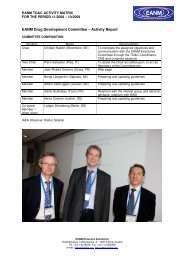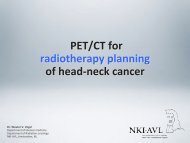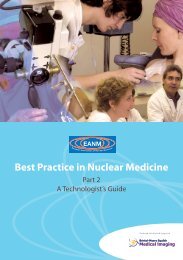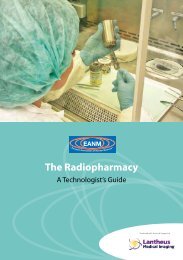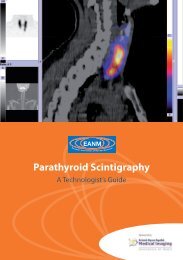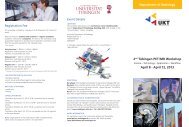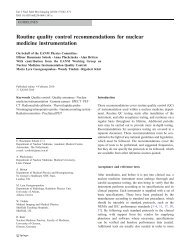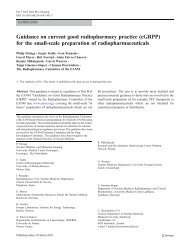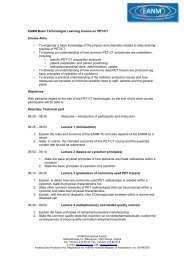Parathyroid Scintigraphy - European Association of Nuclear Medicine
Parathyroid Scintigraphy - European Association of Nuclear Medicine
Parathyroid Scintigraphy - European Association of Nuclear Medicine
Create successful ePaper yourself
Turn your PDF publications into a flip-book with our unique Google optimized e-Paper software.
y recording the time needed to acquire the<br />
flood field using the known activity. It should<br />
not vary by more than a few percent from one<br />
day to another.<br />
Weekly linearity and resolution assessment<br />
Linearity and resolution should be assessed<br />
weekly. This may be done using transmission<br />
phantoms.<br />
Centre <strong>of</strong> rotation calibration<br />
The centre <strong>of</strong> rotation measurement determines<br />
the <strong>of</strong>fset between the axis <strong>of</strong> rotation<br />
<strong>of</strong> the camera and the centre <strong>of</strong> the matrix<br />
used for reconstruction, as these do not correspond<br />
automatically.<br />
The calibration <strong>of</strong> the centre <strong>of</strong> rotation is<br />
made from the reconstruction <strong>of</strong> a tomographic<br />
acquisition <strong>of</strong> a point source placed<br />
slightly <strong>of</strong>fset from the mechanical centre <strong>of</strong><br />
rotation <strong>of</strong> the camera. A sinogram is formed<br />
from the projections and is used to fit the<br />
maximum count locations to a sine wave. Deviations<br />
between the actual and fitted curves<br />
should not exceed 0.5 pixels.<br />
Collimator<br />
The choice <strong>of</strong> a collimator for a given study<br />
is mainly determined by the tracer activity.<br />
This will influence the statistical noise content<br />
<strong>of</strong> the projection images and the spatial<br />
resolution. The number <strong>of</strong> counts needs to be<br />
maximised, possibly at the expense <strong>of</strong> some<br />
resolution and taking into account that in<br />
1<br />
Chapter 3: Imaging equipment - preparation and use<br />
parathyroid imaging the difference in tracer<br />
activity between 99m TcO4 (thyroid only) and<br />
any 99m Tc-labelled agent (thyroid and parathyroid)<br />
must be significant.<br />
Collimators vary with respect to the relative<br />
length and width <strong>of</strong> the holes. The longer the<br />
hole length, the better the spatial resolution<br />
obtained, but at the expense <strong>of</strong> a lower count<br />
sensitivity. Conversely, a larger hole gives a<br />
better count sensitivity but with a loss <strong>of</strong> spatial<br />
resolution.<br />
When using 201 Tl, the available counts are<br />
greatly reduced owing to the long half-life<br />
<strong>of</strong> the isotope and the consequent limited<br />
dose; so traditionally a low-energy generalpurpose<br />
collimator is recommended. With<br />
99m Tc-pertechnetate and 99m Tc-labelled agents,<br />
count rate is no longer a major limitation, and<br />
furthermore, the resolution <strong>of</strong> a high-resolution<br />
collimator decreases less with distance<br />
from the source than does that <strong>of</strong> a generalpurpose<br />
collimator. Thus a high-resolution<br />
collimator is currently recommended for<br />
SPECT imaging, despite the lower sensitivity.<br />
Although the choice <strong>of</strong> collimator is crucial, it<br />
should be borne in mind that other technical<br />
aspects play an important role in determining<br />
optimal spatial resolution, such as the matrix<br />
size, the number <strong>of</strong> angles and the time per<br />
view.<br />
Matrix and zoom factor<br />
The SPECT images (or projections from the<br />
EANM






